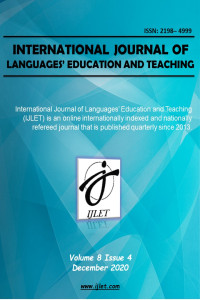Tümüyle Kahoot: İngilizceyi Yabancı Dil Olarak Öğrenen Öğrenciler İçin Rekabetçi Öğrenmeyi Teşvik Etme
Öz
Gelişen teknolojilerle birlikte oyunlar, PC'ler, tabletler ve cep telefonları gibi farklı cihazlarda birçok alternatif öğrenme yolları
sunarak eğitim sektöründe öne çıkmaktadır. Oyunların aktif öğrenmeyi, eleştirel düşünme becerilerini, bilgi oluşturmayı, iş
birliğini ve elektronik bilgi formlarına erişimi teşvik ettiği bir gerçektir (Ellis ve diğerleri, 2006). Oyunların sağladığı avantajlar
göz önünde bulundurularak, bu çalışma bir dil öğrenme ve geliştirme oyunu olan Kahoot'un sınıfta kullanımının İngilizceyi
yabancı dil olarak öğrenen öğrencilerin İngilizce öğrenmeye olan ilgi ve motivasyonlarını üzerindeki etkisini ortaya koymak için
yapılmıştır. Çalışmanın bir diğer amacı da İngilizceyi yabancı dil olarak öğrenen öğrencilerin sınıfta Kahoot kullanılarak
geliştirdikleri dil kazanımları hakkındaki görüşlerini ortaya çıkarmaktır. Çalışma aynı zamanda bu öğrencilerin Kahoot kullanımı
sırasında yaşadıkları zorlukları ortaya çıkarmaya çalışmıştır. Çalışmanın katılımcıları, uygun örnekleme stratejisi ile seçilen 73
İngilizceyi yabancı dil olarak öğrenen öğrencidir. Araştırma sorularına yanıt bulmak için Bicen ve Kocakoyun (2018) ve Benhadj,
Messaoudi, Nfissi (2019) 'den uyarlanmış bir anket ile yarı yapılandırılmış katılımcı görüşmeleri kullanılmıştır. Anket yoluyla
elde edilen veriler SPSS 25 istatistik paketi kullanılarak analiz edilirken görüşme yoluyla elde edilen verilen kategorik içerik
analizi stratejisi kullanılarak analiz edilmiştir. Çalışmanın bulguları, Kahoot kullanımının İngilizceyi yabancı dil olarak öğrenen
öğrencilerin dil öğrenmeye olan ilgileri ve motivasyonlarını artırdığını ortaya koymuştur.
Anahtar Kelimeler
Kaynakça
- Aqsha, M., & Pei, C. (2009). Language learning via ICT: Uses, challenges and issues. Wseas transactions on information Science and applications, 6(9), 1453-1467.
- Ares, A. M., Bernal, J., Nozal, M. J., Sánchez, F. J., & Bernal, J. (2018, May). Results of the use of Kahoot! gamification tool in a course of Chemistry. In Fourth International Conference on Higher Education Advances.
- Benhadj, Y., El Messaoudi, M., & Nfissi, A. (2019). Investigating the Impact of Kahoot! on Students' Engagement, Motivation, and Learning Outcomes: Ifrane Directorate as a case study. International Journal of Advance Study and Research Work, 2(6), 2581-5997.
- Bicen, H., & Kocakoyun, S. (2018). Perceptions of students for gamification approach: Kahoot as a case study. International Journal of Emerging Technologies in Learning (iJET), 13(02), 72-93.
- Blake, R. J. (2013). Brave new digital classroom: Technology and foreign language learning. Georgetown University Press.
Öz
With developing technologies, games have become prominent in the education industry by providing many alternative learning
opportunities on different devices such as PCs, tablets and mobile phones. It is a fact that games stimulate active learning, critical
thinking skills, knowledge building, collaboration, and operative use and access to electronic forms of information (Ellis et al.,
2006). Considering the advantages provided by games and gamification, this study was conducted to find out whether the use of
Kahoot, a language learning and development game, in the classroom, enhances EFL students' engagement in and motivation
towards learning English. Another aim of the study was to uncover the views of EFL students about the language outcomes
developed by using Kahoot in the classroom. The study also dealt with the challenges faced by EFL students during Kahoot
implementation in the classroom. The participants of the study were 73 EFL students who were selected through convenience
sampling technique. A questionnaire that was adapted from Bicen and Kocakoyun (2018) and Benhadj, Messaoudi, Nfissi (2019)
and semi-structured interviews with the participants were used to find answers to the research questions. While the data obtained
through the questionnaire was analyzed by using SPSS 25 statistical package, the data obtained from the semi-structured
interviews were analyzed by adopting a categorical-content analysis strategy. The findings of the study indicated that using
Kahoot enhanced EFL students' engagement in and motivation towards language learning and provided many language benefits
for the learners. It was also assumed that Kahoot sessions helped learners develop their language areas such as grammar
knowledge, vocabulary learning and reading comprehension.
Anahtar Kelimeler
Kaynakça
- Aqsha, M., & Pei, C. (2009). Language learning via ICT: Uses, challenges and issues. Wseas transactions on information Science and applications, 6(9), 1453-1467.
- Ares, A. M., Bernal, J., Nozal, M. J., Sánchez, F. J., & Bernal, J. (2018, May). Results of the use of Kahoot! gamification tool in a course of Chemistry. In Fourth International Conference on Higher Education Advances.
- Benhadj, Y., El Messaoudi, M., & Nfissi, A. (2019). Investigating the Impact of Kahoot! on Students' Engagement, Motivation, and Learning Outcomes: Ifrane Directorate as a case study. International Journal of Advance Study and Research Work, 2(6), 2581-5997.
- Bicen, H., & Kocakoyun, S. (2018). Perceptions of students for gamification approach: Kahoot as a case study. International Journal of Emerging Technologies in Learning (iJET), 13(02), 72-93.
- Blake, R. J. (2013). Brave new digital classroom: Technology and foreign language learning. Georgetown University Press.
Ayrıntılar
| Birincil Dil | İngilizce |
|---|---|
| Konular | Dil Çalışmaları (Diğer) |
| Bölüm | Araştırma Makalesi |
| Yazarlar | |
| Yayımlanma Tarihi | 30 Aralık 2020 |
| Yayımlandığı Sayı | Yıl 2020 Cilt: 8 Sayı: 4 |


